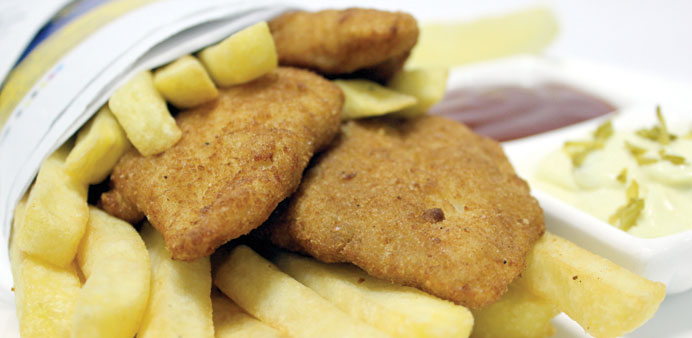Fish and chips are a worldwide favourite take-away food comprising battered fish and deep-fried chips, accompanied by tartar sauce and mushy peas. The dish originated in Great Britain in the 19th century, where the fish served is commonly cod or haddock.
Fish and chips rapidly became a stock meal option for working class and simple take away joints sprung up like mushrooms. In the United Kingdom, Ireland, Australia, Canada, New Zealand and South Africa, fish and chips usually sell through independent restaurants and take away.
Outlets range from small affairs to chain restaurants. Locally-owned seafood restaurants are also popular in many local markets. Mobile “chip vans” serves to cater for temporary occasions. Some shops have amusing names, such as ‘A Salt and Battery’, ‘The Cod Father’, ‘The Frying Scotsman’, ‘Oh My Cod’, and ‘Frying Nemo’.
In Britain and Ireland, cod and haddock appear most commonly as the fish used for fish and chips, but vendors also sell many other kinds of fish, especially other white fish, such as pollock, plaice, skate, and ray.
Traditional frying uses beef dripping, however, vegetable oils, such as peanut oil now predominate. A minority of vendors in the north of England and Scotland and the majority of vendors in Northern Ireland still use dripping or lard, as it imparts a different flavour to the dish.
Fish-and-chip shops traditionally wrap their product in a newspaper, or with an inner layer of white paper to absorb grease, though the use of newspaper has almost ceased on grounds of hygiene. Nowadays establishments usually use food-quality wrapping paper, occasionally printed on the outside to emulate newspaper. Below recipe is a slight deviation from the traditional one and is my choice for my fish and chips.
Fish and chips
Ingredients
(Serves 2)
Cod fish fillets 600g
Flour 1 cup
Salt to taste
White pepper powder to taste
Egg white 2 no
Lemon juice 2 tbsp
Bread crumbs 3 cup
Oil to fry
Method
Wash and cut the fish into desired size and marinate with salt and lemon juice for 30 minutes.
Make a batter using flour, stiffly beaten egg whites, water and seasoning.
Remove the fish from marinade and dip in prepared batter to coat evenly.
Remove the excess batter from fish fillet and crumb one by one, pat gently to coat uniformly.
Deep fry over medium heat and drain on kitchen paper.
Serve hot with fried potato chips, tartar sauce and ketchup.
Note: UK restaurants traditionally use a simple water and flour batter, adding a little sodium bicarbonate (baking soda) and a little vinegar to create lightness, as they create bubbles in the batter. Other recipes may use milk batters where these liquids are often substitutes for water and give a more rich taste to the fish.
Prawn and pasta
Ingredients
Tiger prawns 300g
Penne pasta 100g
Bell peppers 1 no
Cherry tomato 6-8 no
Olives 10-12 no
Parsley 2 sprigs
Dressing
Olive oil 2 tbsp
Yellow mustard 1 tbsp
Lemon juice 2 tbsp
Black pepper crushed as required
Salt to taste
Method
Clean and wash the prawns and steam them for five minutes and keep aside.
Cook al dente pasta in
salted water and toss with some
oil.
Whisk together the ingredients for dressing and make the dressing for the salad.
Heat oil in a pan and add diced bell pepper, boiled pasta and olives.
Drizzle half on the prepared dressing and toss gently.
Mould the prepared mixture in the plate and arrange steamed prawns on top.
Place cherry tomato quarters on the side and garnish with parsley sprig.
Drizzle the remaining dressing on top and serve warm.
Note: This is a slight different variation where unlike most of the salads which are served cold or chilled this is served warm as it comprises prawns which are more delicious when they are hot or warm. You can also include a lettuce of your choice as a base for the above salad.

Fish and chips
